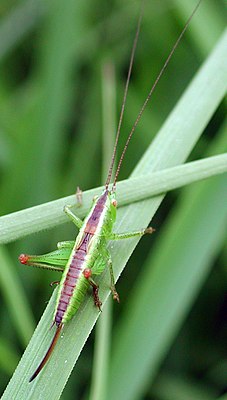Short-winged sword terrier
| Short-winged sword terrier | ||||||||||||
|---|---|---|---|---|---|---|---|---|---|---|---|---|

Short-winged sword insect |
||||||||||||
| Systematics | ||||||||||||
|
||||||||||||
| Scientific name | ||||||||||||
| Conocephalus dorsalis | ||||||||||||
| ( Latreille , 1804) |
The short-winged sword horror ( Conocephalus dorsalis ) is a 1–1.5 cm long representative of the sword horror (Conocephalinae) and belongs to the long- feeler horror (Ensifera).
features
It has a pointed head and a protruding forehead. So the head looks conical. The body color is grass-green in both sexes, about the same size, with the eponymous continuous brown stripe over the entire back. Females have a clearly curved laying spine approx. 9 millimeters long. The wings are hardly developed in the female, those of the male are about 8 mm long. In terms of shape, this long- feeler terrifying species is somewhat reminiscent of the common oak shrimp ( Meconema thallassinum ) in a stronger version. However, there is also a long-winged form, which at first glance can be confused with the long-winged sword-hound ( Conocephalus discolor ). In this species, the laying tube ( ovipositor ) of the female is straight and not curved. To distinguish between the males, it is necessary to take a closer look at the cerci .
habitat
This species loves moisture, it is hygrophilous , and is therefore widespread on moist to wet meadows such as wet meadows and on slowly flowing streams with floating plants . Well-sunlit habitats, flat moors, reed beds and Grossseggenriede are preferred. Its distribution area is northern Germany , southern England and southern Scandinavia .
Way of life
The short-winged sword insect feeds mainly on plants, but sometimes also on insects . Both sexes are unable to fly. In the grass, the animals flee jumping on approach. When staying on thick plant stems, they evade view by skillfully changing their position to the side facing away from the observer. They like to bask in the evening sun on tall plant stems. After mating, the females lay the eggs in leaf sheaths or hollow plant stems with the help of their laying tubes .
Organ of stridulation, song
In adult males, the forewings measure an average of 7.70 millimeters. The dorsal field is better developed than the lateral field. In the area of the vocal organ, the dorsal field is widened inward, and it also makes up a large proportion of the entire front wing (picture). The shrill bar on the left wing measures 1.35 millimeters in the middle and has an average of 59.75 shrill teeth. These are shaped like cusps, their upper side is flattened and covered with small teeth (see illustration in Conocephalus fuscus ). The mirror of the left wing is indistinct. On the other hand, it is well developed on the right wing (picture), while the shrill ridge has receded here. The mean value for the length of the shrill ledge on the right wing is only 1 millimeter, with an average of 40.50 shrill teeth. The measurements of this species are based on only four males who come from the immediate vicinity of the Maisinger See near Starnberg, Upper Bavaria. Females were not available. The singing is soft and can only be heard a few meters away. It is like a persistent whirring in which two acoustically different parts alternate with each other.
supporting documents
Individual evidence
- ↑ Anna Alfonsa Stark: Investigations on the sound organ of some crickets and grasshopper species, at the same time a contribution to the right-left problem. Zoological Yearbooks, Department of Anatomy and Ontogeny of Animals 77, pp. 9–50, 1958.
- ↑ Heiko Bellmann: Observe and determine locusts. 3. Edition. Augsburg, Naturbuch-Verlag
literature
- Helgard Reichholf-Riehm: Insects. 1984, Munich
- Heiko Bellmann: Observe and determine locusts. 3. Edition. Augsburg, Naturbuch-Verlag
- Peter Detzel: The locusts of Baden-Württemberg. 1998, Stuttgart, Ulmer, 580 pp.



